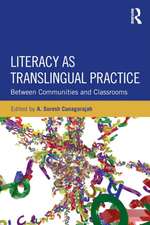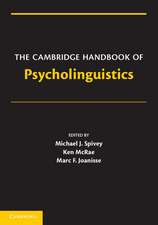Competing Structures in the Bilingual Mind: A Psycholinguistic Investigation of Optional Verb Number Agreement: The Bilingual Mind and Brain Book Series, cartea 2
Autor Elif Bamyacıen Limba Engleză Hardback – 5 ian 2016
Beginning with a thorough survey of the current research of the interface phenomenon in the bilingual mind, the volume then proceeds to present two separate studies on each linguistic interface type, namely semantics-syntax interface and syntax-pragmatics interface, thus filling a number of gaps in the bilingualism research with regards to the interface phenomenon The results and conclusions of these studies are then integrated with current knowledge and research from the field within a theoretical and processing-based framework in order to explore new psycholinguistic insights for the bilingual mind, specifically the conclusion that the grammar of bilingual speakers is shaped according to cross linguistic tendencies. Ultimately, it provides a unified account and a comprehensive conclu
sion regarding the non-native-like patterns in grammar of bilingual speakers. Serving as a fascinating and timely resource, Competing Structures in the Bilingual Mind: An Investigation of Optional Verb Number Agreement will appeal to bilingualism researchers, clinical linguists, cognitive scientists, experimental linguists, and any linguist specializing in Turkic or Altaic languages.
| Toate formatele și edițiile | Preț | Express |
|---|---|---|
| Paperback (1) | 385.47 lei 43-57 zile | |
| Springer International Publishing – 30 mar 2018 | 385.47 lei 43-57 zile | |
| Hardback (1) | 392.75 lei 43-57 zile | |
| Springer International Publishing – 5 ian 2016 | 392.75 lei 43-57 zile |
Preț: 392.75 lei
Nou
Puncte Express: 589
Preț estimativ în valută:
75.15€ • 78.68$ • 62.18£
75.15€ • 78.68$ • 62.18£
Carte tipărită la comandă
Livrare economică 07-21 aprilie
Preluare comenzi: 021 569.72.76
Specificații
ISBN-13: 9783319229904
ISBN-10: 3319229907
Pagini: 250
Ilustrații: XXIV, 222 p. 25 illus. in color.
Dimensiuni: 155 x 235 x 16 mm
Greutate: 0.53 kg
Ediția:1st ed. 2016
Editura: Springer International Publishing
Colecția Springer
Seria The Bilingual Mind and Brain Book Series
Locul publicării:Cham, Switzerland
ISBN-10: 3319229907
Pagini: 250
Ilustrații: XXIV, 222 p. 25 illus. in color.
Dimensiuni: 155 x 235 x 16 mm
Greutate: 0.53 kg
Ediția:1st ed. 2016
Editura: Springer International Publishing
Colecția Springer
Seria The Bilingual Mind and Brain Book Series
Locul publicării:Cham, Switzerland
Public țintă
ResearchCuprins
1 Introduction.- 2 Theoretical and Empirical Accounts of 'modular mind' .- 2.1 A Historical Background.- 2.2 An Overview on Linguistic Interface Research: Evidence from child and agrammatic speech.- 3 Linguistic Interfaces in Bilingual Research- 3.1 The Interface Syntax in the Grammar of Bilingual Children.-3.2 Interface Syntax in the Grammar of L1 Attriters.-3.3 Interface Syntax in the Grammar of Near-Native L2 learners.- 4 A Review of Research on Heritage Bilingual Speakers.- 4.1 Characteristics of Heritage Languages and Heritage Speakers.- 4.2 Approaches to Understanding the Grammar of HS.- 4.3 Aims of the Book.- 5. Measuring animacy effects on verb number marking: A semantics-morphosyntax interface phenomenon.- 5.1 Interaction of animacy and number marking across languages.-5.2 Factors interacting with verb number in Turkish.- 5.3 An Experimental Approach .-5.4 Effects of animacy on optional verb number marking: Testing monolingual speakers.- 5.5 Discussion.- 5.6 Conclusions.- 5.7 Effects of animacy on optional verb number marking: Testing bilingual speakers 151.- 5.8 Discussion.- 5.9 Conclusions.- 6 Measuring effects of topicality on verb number marking: A pragmatics-morphosyntax interface phenomenon.- 6.1 Interaction of discourse constraints and verb number marking in Turkish.- 6.2 Information structural properties in Turkish.- 6.3 Interaction of discourse constraints and morphosyntax across languages.- 6.4 Experimental Design.- 6.5 Effects of animacy on optional verb number marking: Testing monolingual speakers.- 6.6 Discussion.- 6.7 Conclusions.- 6.8 Effects of topicality on optional verb number marking: Testing bilingual speakers.- 6.9 General discussion and conclusions.- 6.10 Conclusions.- 7 Supporting evidence from categorical data.- 7.1 Experimental Design.- 7.2 Results.- 7.3 Conclusions.- 8. Putting things into a frame.- 8.1 Some MOGUL basics.- 8.2 Language acquisition in MOGUL.- 9. General discussion and conclusions.- 10.- Bibliography.- 11. Appendices.- 11.1 Appendix A: Output Tables.- 11.2 Appendix B: Individual characteristics of monolingual and bilingual participants.
Notă biografică
Dr. Elif Bamyaci is a Post-Doctoral Researcher at the University of Cologne, Germany, in the department of German language and literature. Dr. Bamyaci received her Ph.D. in Linguistics, from the University of Konstanz, Germany.
Textul de pe ultima copertă
This volume combines psycholinguistic experiments with typological investigations in order to provide a comprehensive exploration of the linguistic structure of verb-number agreement in bilingual speakers, with a particular focus on the Turkish language. It takes as its starting point the question of which linguistic structures pose difficulties for bilingual speakers, and then proceeds to evaluate the question by using the interface phenomenon of optional verb number agreement. In doing so, this volume investigates how the bilingual mind handles grammatical structures that demand high processing sources, working towards a processing-based linguistic framework for the bilingual mind.
Beginning with a thorough survey of the current research of the interface phenomenon in the bilingual mind, the volume then proceeds to present two separate studies on each linguistic interface type, namely semantics-syntax interface and syntax-pragmatics interface, thus filling a number of gaps in the bilingualism research with regards to the interface phenomenon The results and conclusions of these studies are then integrated with current knowledge and research from the field within a theoretical and processing-based framework in order to explore new psycholinguistic insights for the bilingual mind, specifically the conclusion that the grammar of bilingual speakers is shaped according to cross linguistic tendencies. Ultimately, it provides a unified account and a comprehensive conclu
sion regarding the non-native-like patterns in grammar of bilingual speakers. Serving as a fascinating and timely resource, Competing Structures in the Bilingual Mind: An Investigation of Optional Verb Number Agreement will appeal to bilingualism researchers, clinical linguists, cognitive scientists, experimental linguists, and any linguist specializing in Turkic or Altaic languages.
Beginning with a thorough survey of the current research of the interface phenomenon in the bilingual mind, the volume then proceeds to present two separate studies on each linguistic interface type, namely semantics-syntax interface and syntax-pragmatics interface, thus filling a number of gaps in the bilingualism research with regards to the interface phenomenon The results and conclusions of these studies are then integrated with current knowledge and research from the field within a theoretical and processing-based framework in order to explore new psycholinguistic insights for the bilingual mind, specifically the conclusion that the grammar of bilingual speakers is shaped according to cross linguistic tendencies. Ultimately, it provides a unified account and a comprehensive conclu
sion regarding the non-native-like patterns in grammar of bilingual speakers. Serving as a fascinating and timely resource, Competing Structures in the Bilingual Mind: An Investigation of Optional Verb Number Agreement will appeal to bilingualism researchers, clinical linguists, cognitive scientists, experimental linguists, and any linguist specializing in Turkic or Altaic languages.
Caracteristici
Presents new data and sound findings in the research of bilingualism and psycholinguistics
Compares syntax-semantics and syntax-pragmatics interfaces using the same linguistic structure
Argues that the grammar of bilingual speakers is shaped according to language universals (Universal Grammar compatible)
Includes supplementary material: sn.pub/extras
Compares syntax-semantics and syntax-pragmatics interfaces using the same linguistic structure
Argues that the grammar of bilingual speakers is shaped according to language universals (Universal Grammar compatible)
Includes supplementary material: sn.pub/extras























